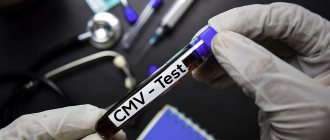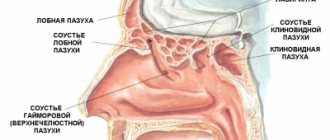Congenital dysfunction of the adrenal cortex -
This is a whole group of hereditary diseases that arise as a result of a defect in transport protein compounds that are involved in the production of the hormone cortisol in the adrenal cortex. Hormones secreted by the adrenal glands are involved in regulating the growth and development of the body. Otherwise, this pathology is referred to as adrenogenital syndrome or adrenal hyperplasia. Diseases of this group are associated with a common development mechanism associated with a decrease in cortisol synthesis, which leads to an increase in the secretion of adrenocorticotropic hormone, resulting in the development of thickening of the adrenal cortex.
Congenital dysfunction of the adrenal cortex
- a hereditary pathology, and the incidence of the disease in boys and girls is the same. There are six clinical variants of congenital adrenal cortex dysfunction, most of which are incompatible with life, which explains the high mortality rate of newborns with this pathology.
According to medical statistics, the vast majority of cases (about 90%) of congenital adrenal hyperplasia are caused by a defect in the 21-hydroxylase protein. The prevalence of this form of the disease correlates with nationality. For example, among representatives of the white race, the disease occurs in one baby in 14,000 newborns, and among Eskimos - 1 case in 280 newborns.
Today, the problem of diagnosing this pathology in most developed countries of the world is solved by conducting neonatal screening for 21-hydroxylase protein deficiency, which is based on determining the level of 17-hydroxyprogesterone in blood taken from the heel of a newborn. This study is carried out with the aim of identifying congenital dysfunction of the adrenal cortex as early as possible, which allows starting hormone replacement therapy before the onset of symptoms of adrenal insufficiency.
Factors that increase the risk of developing congenital dysfunction of the adrenal cortex include the presence of this pathology in one of the parents, or if the parents are carriers of a gene that causes a defect in transport proteins necessary for the synthesis of cortisol by the adrenal cortex. If both parents have a similar gene, in a quarter of cases there is a risk of the child developing pathology.
The mechanism of development of congenital dysfunction of the adrenal cortex
The result of a genetic disorder of transport proteins is a decrease in the production of cortisol and aldosterone in the adrenal cortex, leading to adrenal insufficiency, which in turn causes an increase in the production of adrenocorticotropic hormone by the pituitary gland, which regulates the functioning of the adrenal glands. Hypersecretion of adrenocorticotropic hormone contributes to the development of adrenal hyperplasia and increased production of male sex hormones - androgens. An increase in the concentration of androgens leads to hyperandrogenism, which manifests itself clinically in changes in the genital organs and excessive hair growth on the face and body.
Symptoms of congenital adrenal dysfunction
The clinical picture of congenital dysfunction of the adrenal cortex caused by a defect in the enzyme 21-hydroxylase depends on the degree of its severity and manifests itself in three forms:
- salt-losing form;
- simple virile form;
- non-classical form.
Salt-wasting form of congenital cortical dysfunction
adrenal glands is the most common (occurs in three out of four cases), and develops as a result of complete blockade of the 21-hydroxylase protein, which entails a disruption in the production of glucocorticoids and mineralocorticoids, including cortisol and aldosterone. Beginning during fetal development, congenital dysfunction of the adrenal cortex manifests itself almost immediately after birth with symptoms of adrenal insufficiency and androgen excess.
Newborn girls suffer from female hermaphroditism, which is manifested by the formation of their genital organs according to the male type, namely, an enlargement of the clitoris, its resemblance to the penis and fusion of the labia like the scrotum. The internal genital organs do not change their anatomical shape. However, due to excess androgens, in the absence of therapeutic measures, girls will not experience menstruation.
In newborn boys, congenital dysfunction of the adrenal cortex manifests itself in the form of an increase in the size of the penis and increased pigmentation of the scrotum, as a result of which its color darkens. If hyperandrogenism is not corrected in a timely manner, the disease is prone to rapid progression, which leads to the rapid closure of bone growth plates, resulting in children remaining short in stature. In addition, boys aged 2-3 years experience early deepening of the voice, excessive development of muscles and hair growth in the groin area.
Reduced concentrations of cortisol and aldosterone with congenital dysfunction of the adrenal cortex lead to adrenal insufficiency, which is clinically manifested in the form of sluggish sucking, vomiting, dehydration, decreased activity and darkening of the skin.
Simple virile form of congenital adrenal cortex dysfunction
develops with partial preservation of the enzymatic activity of 21-hydroxylase, so symptoms of adrenal insufficiency are not observed, and the transformation of the genital organs is similar to that of the salt-wasting form.
Postpubertal form of congenital dysfunction of the adrenal cortex
develops with a slight defect in the 21-hydroxylase enzyme, which leads to a moderate decrease in the levels of cortisol and aldosterone and a slight increase in the concentration of adrenocorticotropic hormone. This is precisely the reason for the fact that infants do not experience symptoms of adrenal insufficiency and disturbances in the structure of the external genitalia. The disease can be detected when patients present with infertility problems or menstrual dysfunction, as well as with excess male pattern hair. In some cases, the genetic defect of the enzyme is so insignificant that it may not manifest itself clinically throughout life.
Etiology
Depending on which enzyme gene defect led to the development of the disease, several forms of the disease are distinguished, of which the most common is 21-hydroxylase deficiency (95% of cases). It is caused by mutations in the CYP21A2 gene, most often caused by recombination between the functionally active CYP21A2 gene and the CYP21A1P pseudogene, located close to each other on the short arm of the 6th chromosome. A pseudogene that carries multiple mutations is inactive, that is, it does not encode a protein.
Thus, there are three groups of mutations leading to the development of CAH. Mutations of the first group are associated with gene conversion, the transfer of fatal pseudogene mutations to the active gene, and occur in 70% of cases. Mutations of the second group, accounting for about 30%, are associated with the formation of chimeric genes from an active gene and a pseudogene due to large deletions. Mutations of the third group are rare and are associated with spontaneous mutations in an active gene.
In the classical form, both alleles of the CYP21A2 gene carry severe mutations: large deletions, nonsense mutations, or chimeric genes. The most common mutations are In2G, Q318X, I172N and some others. Patients with NF CAH are heterozygotes or, most often, compound heterozygotes, that is, they have different mutant alleles. In 1/2 - 2/3 of cases, a combination of a “severe” mutation on one allele of the gene and a point mutation on the other allele is observed, while the clinical picture is determined by the “milder” mutation. The most common mutations associated with the development of NF CAH are V281L, P30L, P453S.
Diagnosis of congenital dysfunction of the adrenal cortex
Along with the analysis of anamnestic data, which makes it possible to identify the presence of a similar pathology in the family history, an objective examination, the main criterion for making a diagnosis is laboratory data. Determination of the level of 17-hydroxyprogesterone (a precursor of cortisol) and the level of androgens is one of the main diagnostic criteria for congenital adrenal dysfunction caused by a defect in the 21-hydroxylase enzyme.
Deficiency of the adrenal hormone aldosterone can be detected by measuring the level of renin activity in the blood plasma, an increase in which is characteristic of the salt-wasting form of the pathology. Additionally, the level of adrenocorticotropic hormone in the blood is examined, high levels of which, together with other laboratory data, will confirm the presence of congenital dysfunction of the adrenal cortex. Modern diagnostic methods also involve genetic analysis to identify a gene that damages transport enzymes.
Neonatal screening, carried out 4-5 days after the birth of a child and involving the study of 17-hydroxyprogesterone in the baby’s heel blood, allows us to identify congenital dysfunction of the adrenal cortex at the earliest possible date.
The influence of heterozygous mutations in the CYP21A2 gene on the development of CAH
An important problem in the study of CAH is the question of what effect carriers of mutations in the CYP21A2 gene have on patients, since the frequency of occurrence of heterozygotes ranges from 1:60 to 1:10 among various ethnic groups, among Ashkenazi Jews it reaches 1:3.
Some researchers report that patients who are heterozygous for mutations in the CYP21A2 gene have an increased risk of developing hirsutism, premature pubarche, and severe acne.
According to Vassos Neocleous et al., women who carry mutations in the CYP21A2 gene exhibit clinical signs of hyperandrogenemia, laboratory tests show increased levels of 17-hydroxyprogesterone and decreased concentrations of 11-deoxycorticosterone and aldosterone in the blood compared to normal. According to the results of other studies, single mutations in the CYP21A2 gene are often observed in girls with premature pubarche.
In a study by Admoni et al. all carriers were divided into 2 groups: heterozygous family members of patients with the classical form and symptomatic carriers who had clinical manifestations of androgen excess and also had a mutation in one of the alleles. The level of 17-hydroxyprogesterone in all heterozygotes was higher than in people with a normal genotype. It was noted that the V281L mutation occurs most often in heterozygotes. In carriers of this mutation, the level of 17-hydroxyprogesterone was higher than in carriers of other single mutations. In addition, this mutation was much more common among symptomatic heterozygotes (58%) than among family members (22%). The mechanism of formation of hyperandrogenemia associated with the V281L mutation in the presence of one normal allele has not been fully studied, however, Admoni et al. hypothesized that in this case the cause is a dominant-negative effect, as a result of which the mutant enzyme competes with the normal one, sharply reducing its activity. Other studies support this hypothesis. Thus, it was noted that patients with V281L have an increased risk of developing hirsutism, while among heterozygotes with other mutations it was equal to the population risk. Therefore, it can be concluded that clinical attention should be paid to V281L carriers, since the risk of developing complications of hyperandrogenemia in these patients is higher than in heterozygotes with more severe mutations. This is probably due to the fact that when one allele of a gene is affected by a severe mutation, the enzyme synthesized from it is completely devoid of activity, which makes a dominant-negative effect impossible. For timely administration of therapy, it is important to monitor symptomatic heterozygous patients before and after puberty, since there is a risk of developing additional clinical manifestations.
Treatment of congenital adrenal dysfunction
Based on the cause of the development of the pathology and the inability to influence it, treatment measures consist of providing the patient with hormone replacement therapy throughout his life, which involves compensating for the lack of cortisol and suppressing the production of androgens in the adrenal cortex. The dosage of glucocorticoids is selected individually, based on the age and total body area of the patient (the average daily maintenance dose is 10-15 mg/sq.m. body surface). Prednisolone and dexamethasone, which have a prolonged effect, are more favorable for use in adult patients, as they cause a growth retardation effect that is undesirable for the child’s body. For children, the use of a natural glucocorticoid, hydrocortisone in Cortef tablets, is considered optimal.
If plasma renin activity is elevated, indicating decreased aldosterone levels, mineralocorticoids are required. The most common use is fludrocortisone, the dose of which should be selected taking into account laboratory data on renin activity, and is approximately 0.05-0.15 mg/day. Occasionally, saline (sodium chloride) administration is required if mineralocorticoid saturation occurs.
Such forms of congenital dysfunction of the adrenal cortex, which occur with a pronounced impairment of androgen production, require, starting from adolescence, the prescription of hormone replacement therapy with sex steroids, taking into account the chosen gender. If the diagnosis of the disease is carried out late and the woman’s genitals are developed according to the male type, they resort to surgical intervention, which involves plastic surgery of the external genitalia.
Excessive hair growth has to be combated using various hair removal methods. The non-classical form of congenital adrenal dysfunction requires treatment only in the presence of hirsutism or acne, as well as in cases of impaired fertility. In this case, oral contraceptives are indicated for women - Diana, Janine, etc.
The prognosis of the disease is directly related to how timely the diagnosis of congenital dysfunction of the adrenal cortex is made and whether the correct correction scheme is chosen.
Consultations for patients with adrenal diseases are carried out:
| Sleptsov Ilya Valerievich, Endocrinologist surgeon, Doctor of Medical Sciences, Professor of the Department of Surgery with a course in surgical endocrinology, member of the European Association of Endocrine Surgeons | |
| Rebrova Dina Vladimirovna, Endocrinologist, Candidate of Medical Sciences. Assistant at the Department of Endocrinology named after Academician V.G. Baranov, North-Western State Medical University named after I.I. Mechnikov. Member of the European Society of Endocrinologists, International Endocrinological Society, St. Petersburg Association of Endocrinologists. | |
| Fedorov Elisey Alexandrovich, Surgeon-endocrinologist of the highest qualification category, Candidate of Medical Sciences, specialist at the North-West Center for Endocrinology. One of the most experienced surgeons in Russia performing operations on the adrenal glands. The operations are performed using a minimally traumatic retroperitoneoscopic approach through lumbar punctures, without incisions. | |
| Chinchuk Igor Konstantinovich , Endocrinologist surgeon, oncologist, candidate of medical sciences, member of the European Thyroid Association (ETA). Performs endoscopic operations on the adrenal glands. Retroperitoneoscopic approach. More than 350 surgical interventions per year, half of which are endoscopic. |
Consultations are carried out in outpatient branches of the center:
- Petrograd branch
(St. Petersburg, Kronverksky pr., 31, 200 meters from the Gorkovskaya metro station, telephone for appointment, from 7.30 to 20.00, daily);
— Primorsky branch
(St. Petersburg, Savushkina st., 124, building 1, 250 meters to the right from the Begovaya metro station, telephone for appointments from 7.00 to 21.00 on weekdays and from 7.00 to 19.00 on weekends).
For consultation, please bring all available examination results.
Sources
- Fruzzetti F. et al: Influence of the ovaries on adrenal androgen secretion in polycystic ovary syndrome. Fertility and infertility;
- Rittmaster RS: Clinical relevance of testosterone and dihydrotestosterone metabolism in women, Am. J. Med.;
- Azziz R: Hyperandrogen-insulin-resistant acanthosis nigricans syndrome: therapeutic resonance. Fertility and infertility;
- Ibanez L, et al: Localization of the source of androgen excess in adolescent girls. Journal of Clinical Endocrinology and Metabolism;
- Barnes RB et al: Ovarian hyperandrogenism due to congenital disorders of adrenal virilization: evidence for perinatal masculinization of neuroendocrine function in women. Journal of Clinical Endocrinology and Metabolism;
- Buyalos R.P. et al.: Relationship between circulation, obesity and hyperinsulinemia on serum insulin-like growth factor binding protein-1 in polycystic ovary syndrome. Am. J. Obstet. Gynecol;
- Katz E, et al: Effect of systemic hyperandrogenism on the adrenal response to the hormone adrenocorticotropin. Fertility and infertility;
- Morris RS et al: Prorenin is elevated in polycystic ovary syndrome and may reflect hyperandrogenism, fertility, and infertility;
- Varenik-Shimankevich A. Androgenization syndromes in women. Clinical perinatology and gynecology;
- Yann R, et al: Ultrasound assessment of ovarian stromal hypertrophy in hyperandrogenism and ovulation disorders: visual analysis versus computerized quantification, Fertility and Sterility.
ONLINE REGISTRATION at the DIANA clinic
You can make an appointment by calling the toll-free phone number 8-800-707-15-60 or filling out the contact form. In this case, we will contact you ourselves.
ATTENTION PATIENTS!
Currently, the North-Western Endocrinology Center provides free surgical treatment for patients with adrenal tumors
. Treatment is carried out within the framework of the compulsory medical insurance program or the SMP program (specialized medical care).
To obtain free hospitalization for out-of-town patients
you must send copies of documents (passport: page with photo and basic data, page with registration; compulsory health insurance policy, SNILS, results of existing examinations - a detailed list is presented below) to the address
Questions about hospitalization can be asked to the responsible administrator, Valentina Petrovna Kleshnina, by calling +7 900 6291427 (weekdays, from 9 a.m. to 5 p.m.).
Package of necessary examinations
should include the following list (if there are no results from the listed studies, they must be performed in any case):
- CT or MRI of the abdominal cavity, if there is only an ultrasound report, then it is necessary to perform a CT scan of the abdominal cavity without contrast, indicating the native density of the adrenal tumor (if necessary, print this item and show the CT scan to the doctor before the study).
The following laboratory parameters must be determined:
- Aldosterone, renin, potassium in the blood, in case of taking diuretics, they must first be discontinued for three weeks (tests are taken in the morning from 8 to 9 am, sit for 15 minutes before taking the tests), after taking these blood tests, resume taking your previous medications;
- Analysis of 24-hour urine or blood for total metanephrines;
- Performing a test with 1 mg of Dexamethasone (in the evening, at 23:00, take 2 tablets of Dexamethasone, in the morning of the next day - from 8 to 9 in the morning, determining the level of cortisol in the blood), the analysis is taken separately from the others, in the last place.
You must also provide information
about the normal level of blood pressure in the patient (working blood pressure), if the pressure increases, indicate the maximum blood pressure numbers, how long ago the increase has occurred and how often rises in blood pressure occur.
To carry out the above examinations, there is no need to go to the hospital; they can be performed at your place of residence or in the nearest laboratory.
For patients from St. Petersburg
It is advisable to apply for a face-to-face consultation before entering the clinic (make an appointment by phone (812) 565-11-12, Primorsky branch of the center, address: Savushkina St., 124, building 1, make an appointment by phone (812) 498-1030, Petrograd branch of the center, address: Kronverksky pr., 31).







